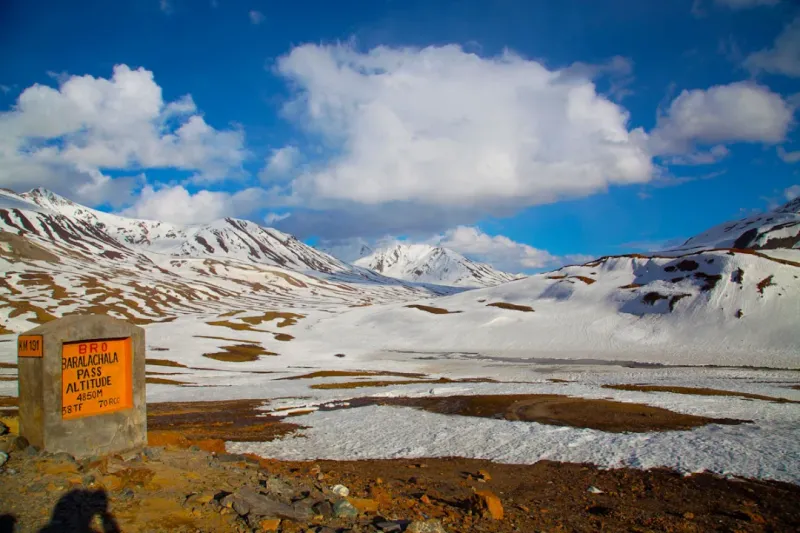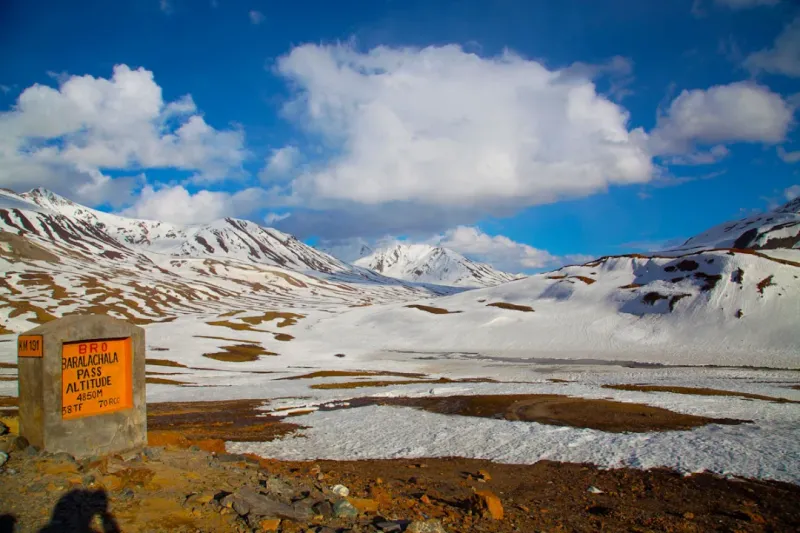
Baralacha Pass Weather | Best Time & Travel Guide 2025
Baralacha Pass Weather: Complete Guide for Travellers
If you’ve ever dreamt of driving on the legendary Manali–Leh highway, chances are you’ve already heard of Baralacha Pass. Standing tall at over 4,890 metres, this mountain pass is not just a road but an experience. However, the one factor that decides whether your journey will be smooth or extremely challenging is the Baralacha Pass weather.
At such high altitude, the climate changes rapidly. One moment you may find bright sunshine lighting up the snow-capped peaks, and the next you may be stuck in cold winds or even snowfall. That’s why knowing the Baralacha Pass weather before you plan is not just useful but essential. From deciding the best month to travel, to understanding how the Baralacha Pass temperature affects road conditions, everything depends on the season.
Where is Baralacha Pass and Why Weather Matters?
Baralacha Pass, also known as Baralacha La, lies in the Lahaul region of Himachal Pradesh and connects the districts of Lahaul in Himachal with Ladakh in Jammu & Kashmir. At an elevation of about 4,890 metres, the Baralacha La elevation makes it one of the highest motorable passes on the Manali–Leh route.
The pass is unique because it acts as a meeting point for roads leading to Ladakh, Spiti, and Lahaul. Many bikers and road trip enthusiasts cross it while travelling from Manali to Baralacha Pass and onwards to Leh. However, the height and location mean it is completely weather-dependent. For more than six months every year, snow buries the pass, making it impossible for vehicles to move.
This is why travellers keep searching for updates like Baralacha Pass weather today or Baralacha La pass weather before their trips.
What is the Best Time to Visit Baralacha Pass?
The best time to visit Baralacha Pass is between June and September. This is the period when the snow begins to melt and the Border Roads Organisation clears the highway for traffic. The road becomes accessible, and the weather, though cold, is bearable compared to the harsh winters.
If you are travelling for adventure or photography, this season offers the most reliable conditions. However, even in these months, it’s important to remember that the Baralacha Pass weather can be unpredictable. Sudden snowfall or rain can block the way, so flexibility in travel plans is a must.
Baralacha Pass Weather in Summer (May–June)
As summer begins in lower Himachal, the snow starts melting in the higher regions. By late May or early June, the Border Roads Organisation usually clears the snow, and vehicles begin to move.
During these months, the Baralacha Pass temperature during the day ranges between 5°C and 15°C, but nights still drop close to freezing. Travelling at this time means you will encounter stretches of melting snow, water crossings, and slush on the road. This makes the drive adventurous but slightly tricky.
Still, the views are worth it. The pass looks stunning with snow on either side, and the journey feels like you’re driving through walls of ice.
Baralacha Pass Weather in Monsoon (July–August)
The monsoon season adds its own challenges. While regions like Lahaul and Spiti are relatively rain-shadow areas, the approach roads from Manali can experience rainfall. This leads to landslides, slippery roads, and delays.
At the pass itself, the Baralacha weather remains cold but manageable. Daytime temperatures hover between 8°C to 12°C, while nights can touch 0°C. However, because of rainfall in the lower areas, travellers often face blocked roads.
If you plan to cross Baralacha in July or August, keep buffer days and always check road conditions beforehand. Still, this season has its charm—the mountains look greener, the rivers fuller, and the play of clouds creates unforgettable scenery.
Baralacha Pass Weather in Autumn (September–October)
September is considered the best month to travel through Baralacha Pass. The monsoon rains subside, leaving clear skies and crisp air. This is when many bikers from across India take the Manali–Leh highway to enjoy smooth rides and spectacular views.
During September, the Baralacha temperature ranges between 0°C at night to 12–15°C in the day. The roads remain dry, making driving relatively safe. Photographers love this season because the landscape offers sharp contrasts—golden meadows, blue skies, and snow-dusted peaks.
By October, however, the pass starts receiving early snowfalls. Nights turn bitterly cold, and by mid-October, the route usually closes for the season.
Baralacha Pass Weather in Winter (November–April)
Winter is the harshest time at Baralacha La. From November until late April, the pass is buried under several feet of snow. Temperatures drop to as low as –20°C to –25°C, and the region becomes inaccessible.
Travellers often ask, “Can we visit Baralacha Pass in winter?” The answer is no. The highway is closed, and even locals do not attempt to cross it. The only option for winter explorers is to wait until summer returns.
Average Temperature at Baralacha Pass by Month
To give you a clearer idea of the climate, here’s how the Baralacha Pass temperature usually changes:
-
May–June: 5°C to 15°C (day), 0°C to 5°C (night).
-
July–August: 8°C to 12°C (day), around 0°C (night).
-
September: 5°C to 12°C (day), –2°C to 5°C (night).
-
October: 0°C to 10°C (day), –5°C or lower (night).
-
November–April: –10°C to –25°C, inaccessible.
Remember, these are approximate figures. The Baralacha La temperature can vary depending on sudden weather shifts.
How to Check Baralacha Pass Weather Before Travelling?
Before heading to the pass, always check live updates. Reliable weather apps, BRO (Border Roads Organisation) alerts, and traveller forums provide real-time information. You can also ask local taxi drivers in Manali or Keylong, as they usually know the road conditions.
If you’re planning the journey from Manali to Baralacha Pass, start early in the morning. Weather in high-altitude passes tends to worsen by afternoon, with stronger winds and sudden snowfall.
Safety Tips for Travelling in Baralacha Pass Weather
Travelling through Baralacha La is exciting, but safety should come first. Since the Manali to Baralacha Pass distance is around 160 km, the drive can take 5 to 7 hours depending on road conditions. Carry enough fuel, food, and water.
Acclimatisation is crucial because the pass is at nearly 5,000 metres. Altitude sickness is common, so spend a night in Keylong or Jispa before attempting the crossing. Warm clothing, gloves, and good shoes are a must.
And most importantly, do not rush. The beauty of the journey lies in experiencing the changing Baralacha Pass weather, the snowfields, and the stillness of the mountains.
Conclusion
Baralacha La is not just another stop on the Manali–Leh highway. It’s a challenge, a reward, and a memory rolled into one. But every bit of it depends on timing. The best time to visit Baralacha Pass is between June and September, when the weather is supportive and the roads are open.
Travelling here means respecting nature. Plan wisely, check the Baralacha pass weather before you go, and you’ll return with stories you’ll cherish forever.
Top-related blogs: